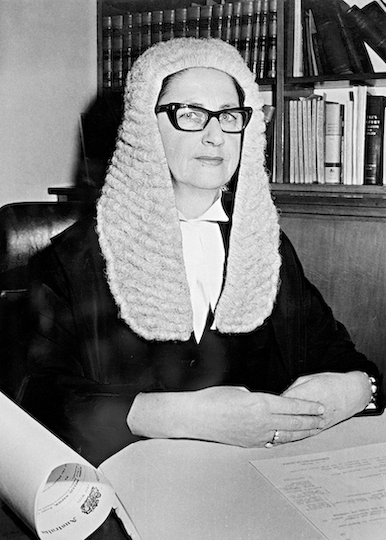Written by Elizabeth Heffernan, RAHS Volunteer
To celebrate Women’s History Month in 2020, the Royal Australian Historical Society will continue our work from last year to highlight Australian women that have contributed to our history in various and meaningful ways. You can browse the women featured on our webpage, Women’s History Month.
As the country’s first female Queen’s Counsel, Supreme Court judge, human rights commissioner, university chancellor and state governor, it is no wonder Dame Roma Mitchell is commonly known as Roma the First. Her illustrious career in the judicial and legislative arms of the South Australian government lasted for six decades and remains unparalleled. The law, and its ability to achieve social justice, “was the great love of her life.” [1]

Roma Mitchell wearing the robes and full bottomed wig of a Justice of the Supreme Court of South Australia, 1965 [Image courtesy National Archives of Australia, A1200, L52938]
Though their family did not have much, Roma’s mother was determined her daughters would receive a good education. She sent them to St. Aloysius’ College where Roma studied law along with music and dancing. She continued to pursue law into the University of Adelaide where she graduated top of her class. While at university, Roma had been barred from joining the Law Students’ Society because she was a woman – she and her friends founded the Women Law Students’ Society instead. [3]
Roma practised as a barrister at Nelligan and Angas Parsons from 1935, and soon made partner. Throughout her time in this position she practised every type of law except criminal, as she was wary of the all-male juries. Her specialty quickly became family law and her advocacy for women would continue to guide her for the rest of her professional career. As John Bannon, former South Australian premier, wrote in her obituary: “She wouldn’t shirk from being a standard bearer.” [4]
In 1962, the same year she became the country’s first Queen’s Counsel, Roma also represented Australia at the United Nations seminar on the Status of Women in Family Law. In 1965, she became a member of the Council of the University of Adelaide and Australia’s first female Supreme Court judge. This latter appointment caused much controversy among commentators – they wondered what she would wear, how she should be addressed in court, and, with capital punishment legal in South Australia until 1973, if it was proper for a woman to condemn a convicted man to death. [5]
During her time on the bench Roma continued to lecture at the University of Adelaide, wrote two books on women’s and Indigenous Australians’ relationship to the law, and successfully campaigned for women jurors to participate in criminal cases. She also chaired a penal reform committee, the Parole Board, and the Australian Human Rights Commission between 1981 and 1986. In 1983, one year after being appointed a Dame Commander of the British Empire, Roma became the first woman outside the royal family to hold the chancellorship of a Commonwealth university. She continued in that ground-breaking position for seven years until 1990.
In 1991, she was made a Companion of the Order of Australia and appointed the Governor of South Australia – once again the first woman to do so. Her retirement in 1996 did little to stifle her passion for justice and helping the disadvantaged. [6]
Shortly before her death in March 2000 she received her final honour – Commander of the Royal Victorian Order. In his valedictory tribute to Roma following her death, fellow South Australian Supreme Court judge Len King summarised her life and work best: “For all her strength and strictness, she was a humane and compassionate judge. She understood people, their problems, their aspirations and their weaknesses.” [7]
The people were lucky to have her.
References:
[2] Zinn, ‘Dame Roma Mitchell’.
[3] Nic Klaassen, ‘Dame Roma Mitchell, AC, DBE, CVO, QC’, Adelaidia, <http://adelaidia.sa.gov.au/people/dame-roma-mitchell-ac-dbe-cvo-qc>, accessed 3 March 2020.
[4] Zinn, ‘Dame Roma Mitchell’; Deidre Jordan, ‘Obituary: The Honourable Dame Roma Mitchell’, Australian Feminist Studies 15, no. 33 (2000), p. 312.
[5] Klaassen, ‘Dame Roma Mitchell’; Zinn, ‘Dame Roma Mitchell’.
[6] Klaassen, ‘Dame Roma Mitchell’; Zinn, ‘Dame Roma Mitchell’.
[7] Len King, ‘Dame Roma Mitchell: A Valedictory Tribute’, Adelaide Law Review 22, no. 1 (2000), p. 25.
